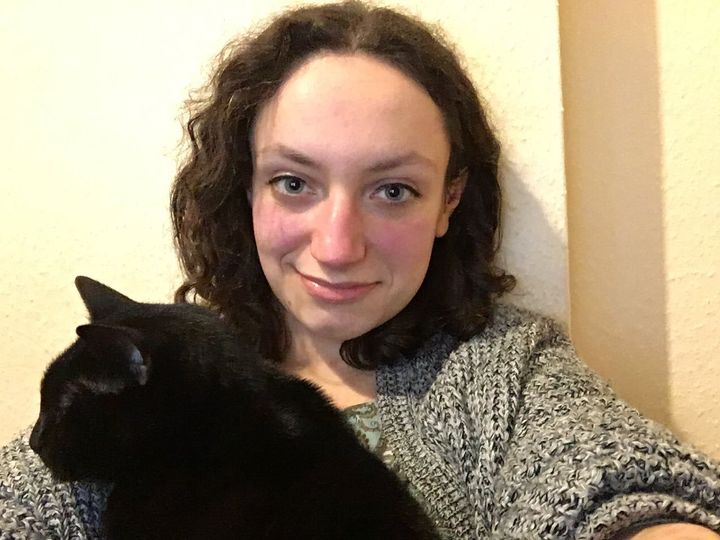More than a third of teenagers and young adults have self-harmed at some point in their lives, with many still baring physical scars on their bodies – in addition to the emotional ones – later in life.
In warmer weather, particularly during 2018’s record heatwave, many people who have self-harmed are faced with an added challenge to trying to keep cool – wearing less often means showing scars, while covering scars can mean overheating and might draw attention. For some, the experience can be empowering, while others say it means encountering judgement.
Rachel Rowan Olive, 26, chooses not to cover her scars in hot weather, but she’s tired of the stigma she often experiences as a result. “It’s just exhausting being on high alert all the time for how people are going to respond,” the illustrator and MA student says. “I can see people’s eyes following me in the street and I hate it.”

When someone self-harms it can be a sign they’re experiencing intolerable emotional distress and self-harming is linked to a number of mental health problems, notably anxiety, depression and PTSD. Although self-harm is most common between the ages of 13 and 24, scars can last much longer, and people’s reactions can add an extra layer of distress.
This summer, which has seen highs of 35 degrees, is the first time Martha Hampson has felt felt comfortable having bare arms in public since she was 15. The 33-year-old, who is head of children’s social care at the social enterprise Innovation Unit, says showing her scars after a long time hiding them has felt liberating.
“I’ve finally been able to do things like go swimming and wear summer dresses without worrying about it,” she says. “I was a self-harmer as a teenager and in my early twenties, and struggled every summer to keep it under wraps.”

For Martha, having a baby was the turning point at which her attitude started to shift: “I’ve got all sorts of physical markers now – stretch marks, scars, feet a size bigger than they were a year ago – and each one is part of the picture of my life and experiences. I realised I was happy to get a boob out [when breastfeeding] but not my arms!”
Sarah, 35, was also encouraged to stop hiding her scars after becoming a mum. The mental health writer and blogger, who chose not to give her last name, decided covering up was no longer an option in 2016 while on a family holiday in Menorca.
“It was just too hot and the kids wanted to go swimming so I went to the pool with a kaftan or cover up and then once on the sun lounger I just took a deep breath and laid in my swimsuit,” she remembers. “It was hard but after two or three days of the two-week holiday, I didn’t think about it as much.”
The summer’s UK heat wave has still been a challenge, but Sarah says: “I still see [my scars] now and worry, but overall I’m much better.”
She adds that her scars tend to appear more prominent with a tan, and recommends using oil and stretch mark creams, alongside wearing sun cream, for those who want to minimise their appearance in summer.
While Martha acknowledges the choice to cover up or to show scars is definitely a personal one, she felt that for her, covering up was also motivated by a mindset of self-harm – the idea that after having self-harmed, covering up in the heat was the price to pay. “[I thought] I deserved to be in discomfort because I’d brought it on myself,” she explains.
Due to the complex relationship many people have with scars, it’s important that people behave appropriately when they see them, whatever the time of year.
Dr Virginia Davies of the Royal College of Psychiatrists says: “If you see someone with self harm scars in public, you shouldn’t feel entitled to approach them or talk to them about it.”
Rachel and Sarah agree that it’s best to leave people with scars alone in public. Rachel says the best course of action is not to comment or give guidance if they haven’t asked for it: “Sometimes people come out with unsolicited advice and it’s a right pain. Unless someone is obviously in extreme distress just leave us to get on with choosing what kind of tomato we want to buy, or whatever we’re doing.”
She notes that people asking questions about what happened is also a common intrusion: “You don’t have the right to know everything about someone else’s body just because we’re existing in a public space.” Sarah adds: “Try not to stare.”
This week NHS figures showed girls aged 18 and under admitted to hospital for self-harm have nearly doubled since 1997, but Dr Davies says we should remember old scars are not always a sign that someone is currently struggling, or that it is an emergency or cause for immediate panic. “Remember there’s a difference between new injuries, particularly those that might need urgent medical attention, and older scars.”
If you are concerned about scars you notice on someone you know, “the most important thing is not having a sensationalised or aghast reaction to it,” advises Dr Davies, who specialises in self-harm. “One of the most important things in terms of responding is to be non-judgmental, calm, and ask whether they might feel comfortable talking about it,” she adds.
There are a host of questions people who have self-harmed will ask themselves during the summer, says Rachel, from “should I be covering in case people think I’m attention-seeking?” to “should I not be covering so I can raise awareness?”
Her conclusion: “Do whatever you need to do to make things bearable...we don’t owe the world anything in exchange for the right to exist in it.”
Useful websites and helplines:
- Mind, open Monday to Friday, 9am-6pm on 0300 123 3393
- Samaritans offers a listening service which is open 24 hours a day, on 116 123 (UK and ROI - this number is FREE to call and will not appear on your phone bill.)
- The Mix is a free support service for people under 25. Call 0808 808 4994 or email: help@themix.org.uk